Introduction
The Ring Commons Sports Centre is testimony to the wonderful community spirit in the area, and its genesis dates back to 1977 when a group of young men decided to reclaim some marshy commons land so that they might re-form a cricket team.
They showed great foresight in naming the ground, Ring Commons Sports Centre, and not Ring Commons Cricket Club because it was anticipated that in time, other sports would be played on the ground. The Centre now consists of a function room, a members' bar, a club house with changing rooms and showers, two football pitches and a pitch and putt course in addition to a cricket pitch and a cricket pavilion.
This development was made possible by a combination of fund-raising, voluntary labour, and a grant from Fingal County Council. The focus of this article will be the period up to 1977 but it is important to pay tribute to the people who have worked so hard to provide and maintain recreational, social, and cultural activities in the Ring Commons Sports Centre.
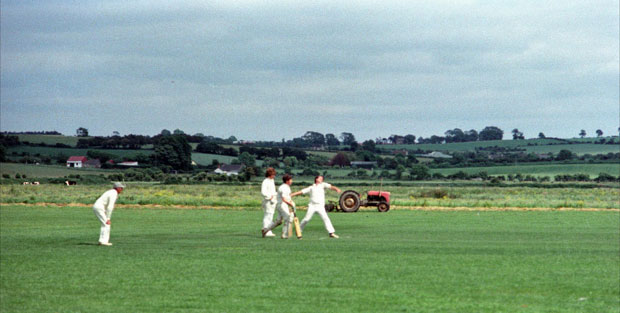
Early Days
The first reference to cricket in Ring Commons was a note in the Drogheda Independent, 19 June 1897 which stated that Ring Commons Cricket Club beat Garristown on Sunday by 20 runs. That is the extent of the report, and in certain respects, it sets the tone for most of the accounts of the games played by the club over the years - scores and results, and nothing else.
In its early manifestations, the club played at Briarland, and some of the reports called the club, Briarland while other reports used the title, Ring Commons. This is illustrated by the accounts which are extant for two games which were played in 1900. In the first report, there is a reference to the Briarland Club having some 'first class players, as is seen by the fact that they carried their bats to victory on every occasion last season'.
In addition to being unbeaten in 1899, it was also unbeaten until Sunday, 17 June 1900 when it played Balbriggan Rovers. Briarland batted first, and was dismissed for 20 runs, with J. Reynolds taking 7 wickets in both innings. In reply, Balbriggan scored 37 in the first innings, and of this total, 16 runs were extras. In Balbriggan's second innings, 6 wickets had fallen at 6 o'clock when time was called, and Balbriggan was deemed to have won based on its first innings score.
There are two reports available for the return game, and stylistic differences in reporting are very evident. The Drogheda Independent's account is prosaic, and it refers to the visitors as Ring CC. The game was played in Balbriggan on 29 June and 'after an exciting game', the visitors won by 8 runs. This win was attributed to the bowling of C. Hagan who took 7 wickets. For Balbriggan, the batting of T. O' Neill (the owner of the ground) 'was the feature of the match, and Jem Brown trundled the leather to the best advantage'. The Drogheda Argus reproduced the score card, and highlighted the contributions from Mr O'Neill (18*) batting at no. 9 and J. Magrane (sic) the top scorer for Briarland with 13 runs.

The report however did not end with the scorecard, and there was a disquieting reference to crowd trouble: The rough element of some of the local spectators which made itself apparent during the progress of the match on last Friday, reflects a serious stain on the reputation of the club. The committee mean to deal seriously with persons causing a disturbance on their grounds, for if such a state of things were allowed to go on, the club would cease to exist.
The above reports are the extent of the information available on Ring Commons CC until April 1913 when William Rooney, the hon. sec., indicated that the club was open for challenges for the coming season. Ring Commons CC visited Gormanston Castle on 31 August to play the local team on the 'lately well laid out grounds presented to the club by Lord Gormanston'. P. J. Curtis, the Gormanstown Secretary, did not lack confidence in his team, and in his report, he mentioned that the home club 'proved successful as usual.' It is difficult to know if it was much consolation to Ring Commons to be told that they had 'hard luck by only getting 22 runs'. The home team sent in 'their old reliable Johnny Clarke of Stamullen to defend the stumps which he did in fine style, as also did the Purfield Brothers'. The bowling on both sides was good, with 'Reilly for the home club and Hughes for the visitors doing best'. The final score was Gormanstown CC, 58 runs; Ring Commons CC, 22.
During the next twelve years, local, national, and international events dominated the print media, and references to cricket in Fingal are minimal. For Ring Commons CC, the re-awakening occurred in 1925 when it played Kilbride at Ring Commons and won on a score of 74 runs to 51. On three successive weeks in the Drogheda Independent, the club advertised the New Year's Dance which was to be held in Ring Commons School.

On Week 1, details of admission prices (Gents: 5s; Ladies, 2s 6d, Doubles, 7s 6d) are given, 'everyone was welcome', refreshments were included in the price, and this dance would be 'the best One Yet'. On Week 2, the advertisement mentioned 'Splendid Music and Excellent Catering', and Week 3, it was reported that the Committee had made 'elaborate arrangements' for New Year's Night. The fact that the Annual Dance was held in the school showed that the school building in addition to its primary function as an educational establishment, served a vital secondary function for the wider community as a venue for meetings and social events.
The close links between the Ring Commons Cricket Club and Ring School have already been mentioned, but the place of the school is enshrined in the history of Fingal cricket because the Fingal League was established in Ring Commons in 1926. The Executive of the League recognised its indebtedness to Rev. J. Hickey by passing a vote of thanks for the use of Ring School for Committee meetings and it made a subscription towards parochial funds.
At an event which was held in 2004 to celebrate the achievements of the school which was closed in the 1970s, a cricket bat was one of the artefacts which was brought to the altar during the Special Mass. There were only two clubs in the Fingal League in 1926, but it was fully operational in 1927, and Ring Commons CC was one of the seven clubs which entered the league. The other teams were Skerries, Knockbrack, Ballymadun, An Macraidh (Knockbrack 11), Knightstown and the Black Hills.
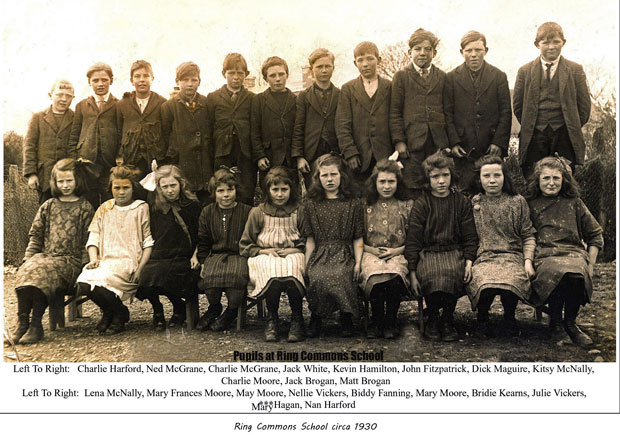
Ring's first season in Fingal League cricket was not too successful, and it ended up with 12 points by comparison with the winners, Skerries, who obtained 33 points. For the 1928 season, the only game for which there is a report available was Ring Commons versus Knightstown which Knightstown won on a score of 50 runs to 33. Despite not being too successful on the field of play, Ring Commons CC was of crucial importance in the administration of the league because in addition to providing a venue for meetings, Mr Michael White gave a field for the staging of the final between Skerries CC and Barnageeragh.
By 1929, the number of teams in the Fingal League had increased to 15, and it was decided to divide the league into 2 sections. Ring Commons CC was in Section A along with Knockbrack, Skerries, Ballymadun, Barnageera, Knightstown, and Balrothery. It fulfilled its 12 fixtures, but success continued to elude it, and its record for the season was won 1 game, lost 11 and scored 328 runs which was an average of 27 runs per game.
In 1930 however there were distinct signs of an improvement, and in its game with Balbriggan, Ring Commons won on a score of 37 runs to 25. It is difficult to know if the reporter was being ironical when he referred to Balbriggan's 'stone-wall defence' being a feature of the game, and 'the fine hitting of Bergin who made two 2's'. The best batsmen for Ring Commons were Dunne (11), McNally (7), R. Lacy (4), and Fanning (4), while Dunne took 6 wickets for Ring Commons. By the end of the season, Ring had played 10 games, won 6, lost 4 and scored 487 runs which was an average of nearly 49 runs, a considerable improvement on the previous season.
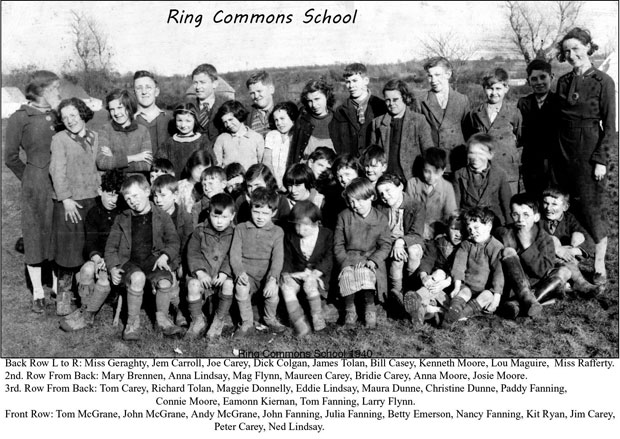
Cricket was not the only sporting activity in Ring Commons during 1930. Some of the young men decided to form a 'push bicycle club' and one of its first events was a reliability trial in which 20 competitors took part, but only 6 finished the course. The trial commenced at Ring National School, went through the playground, via Old Maids' Lane, back to the Commons, and finished with a 'tough struggle up Balrickard Hill.' The competitors had some difficulties on Old Maids' Lane, and at least half a dozen cyclists came to grief there. The reporter was unable to provide the name of the winner, and in justifying this lacuna, he explained that 'he [the winner] appeared at the winning post covered with mud and in such a condition that I believe his own mother would not know him.'
Ring Commons CC held its AGM on 15 March 1931. There was an 'exceptionally large attendance of members'; it was reported that the Club was in a 'very sound position', and that its prospects for the coming season were 'very rosy'. In a clear statement of priorities, about half-way through the Agenda, 'it was decided to have a practice owing to the day being so fine'. The meeting was adjourned until 5 April when the remainder of the Agenda would be addressed, and new members registered. The number of teams in the Fingal League had increased to such an extent that it was deemed necessary to have 3 sections. Ring Commons was in Division B along with Balrothery, Balbriggan, Barnageera, Knightstown and Ballymadun. In one of the early games in the season, Ring Commons beat Ballymadun on a score of 30 runs to 27. By the end of the season, it had played 10 games, won 7, lost 3, scored 329 runs (average of 32.9 per game) and finished second in its section on 14 points.
Club members were also involved in a cricket match between married and single men from Balbriggan, Balrothery and Man-O-War which was arranged to raise funds for Balbriggan Parish, and the club organised a dance on 16 August 1931. Ring Commons CC had a difficult start to the 1933 season with the death of Christopher Hardford (sic) who was referred to as a 'very useful and valuable member, both on the playing pitch and the committee room'. On the playing field, Ring had a successful season, and by 19 August, it was joint top of its section with 7 wins and 2 losses. It was involved in a crucial game against Curkeen where a win for Curkeen would give divisional honours to Curkeen while a win for Ring Commons would necessitate a replay. On the day, Ring Commons responded to the challenge and won by 65 runs to 32. The bowling of Dunne and Rooney was reported to have been 'excellent', while 'the fielding of Ring Commons on the whole was exceptionally good'. The two teams met again at Balbriggan and treated the large crowd to 'fine exhibition of cricket'. The final score was Ring 36 runs and Curkeen 17, and this result was attributed to Ring's fielding and bowling being 'well-nigh perfect'. Dunne of Ring Commons was given a special mention because of his bowling.
This result meant that Ring Commons would play Balcunnin in the final of the Fingal League. Unfortunately for Ring Commons, on a difficult day which was marred by frequent showers, the final was a 'one-sided affair', and it 'proved unequal to the superior bowling and batting of the Balcunnin team who won comfortably by an innings.'
For the 1934 season, the thirteen clubs in the Fingal League were divided into two sections, East and West Fingal. Ring Commons was in the same division as Portrane, Knockbrack, Black Hills, Man-O-War, Balbriggan and Balrothery. The club played 10 games, and won 4, lost 5 and drew 1, and finished the season on 9 points. At the AGM of the League, it was indicated that there would be a representative game between a Fingal League Selection and the Meath League for a trophy which was presented by G. L. McGowan. V. McNally was the Ring Commons' representative on the Fingal team. In 1936, the number of teams in the Fingal League had fallen to 10, and Ring Commons CC was not affiliated to the League for that season. The club did not play in the following two seasons either, but it is possible that some of its players may have opted to play for one of the clubs in the Naul because in 1936, Naul and Naul Hill played in the Fingal League.

Ring Commons CC was represented at the Fingal League's AGM in 1938 by J. Kearns, and it was obvious that the club had resumed its cricketing and social activities. There are no reports available for games played by Ring Commons in 1938, but the club organised a dance in the Naul Hall on Sunday, 30th October, dancing was from 7 to 12 p.m., admission was 1s 3d and there was a guarantee of the 'usual good music'. There is a similar situation regarding reports on games in 1939 but at the AGM in 1940, it was noted in the previous year that Ring Commons had tied with Knockbrack for runners-up for the Fingal Challenge Cup.
There is more information available on the 1940 season, and on 19 May, Ring Commons beat Ballymadun on a score of 48 runs to 35 in 'a well-contested game.' The report on the game between the Black Hills and Ring Commons is matter of fact - 'Black Hills defeated the home team by two wickets.' The return game between Ring Commons and Ballymadun was played at Ring Commons on 30 June 1940, and resulted in a win for Ring Commons. Ballymadun was all out for 35, and Ring Commons' score was 39 for the loss of 6 wickets. The best scorers for Ring Commons were M. Dunne (14*) and J. Maguire (13).

Tom Fanning
The club joined forces with Knockbrack to host a Ceilidhe and Old Time Waltz in the Town Hall, Balbriggan on 26 January 1941, admission was 1s 6d, dancing was from 9 to 1, and the music was provided by Jack Ryan's Band. Ring Commons lost to the Black Hills on a score of 48 runs to 18 in a play-off which would decide who would qualify for the final of the League in 1941. There was a big increase in the club's involvement in social events during this year. It organised a Ceilidhe, Old Time and Modern Dance in the Naul on 10 August, dancing was from 8 to 12, admission was 1s 6d and music was by Harry Magee's Band. There was a 'Grand Novelty Dance' in the Naul on 5 October with the same price, same band and same duration. Finally, in conjunction with Knockbrack CC, Ring Commons organised a Ceilidhe, Old and Slow Waltz in the Town Hall, Balbriggan on 19 October, and this was advertised as 'a dance you are sure to enjoy'.
In 1942 the rationing of motor fuel during the Emergency continued to have an impact, and the League was divided into two divisions to minimise these transport difficulties. Ring Commons was in the same division as Balrothery, Clonard, Walshestown, Rush, and the Black Hills. The only other mention of Ring Commons is contained in a report on a game between Rush and the Irish Times, in which J. McDermott, formerly a member of Ring Commons CC, scored 30 runs. At the AGM in 1943, the following officers were elected for the season: Captain: John Kearns, Vice- Captain: P. White, Hon. Sec.: E. P. Moore, Hon. Treas.: Jas Kearns; Committee: the above with George and Christy Casey. The meeting recorded its thanks to Mr Patrick Reilly, Saddlestown House, Stamullen, for the use of the field. On 16 May, Ring Commons was due to host Oldtown, but Oldtown did not travel. The continuing importance of the corporate identity of the Fingal League was reflected in the game between a Phoenix Selection and a Fingal League Selection which was played at Balbriggan. E. P. Moore of Ring Commons was named among the substitutes for the Fingal team.
Between 1944 and 1947, Ring Commons continued to play Fingal League cricket, but it was evident that the club was struggling on the cricket field. In 1945, it was well-beaten by the Black Hills on a score of 43 runs to 21. In 1946, Ring Commons lost to Bohill, and then it was reported that 'Balrothery had a very big win over Ring Commons'. At the end of the season, Ring Commons ceased to be involved in Fingal League cricket and it did not return to cricket until 1961.

John Fanning
The existence of the Fingal League was beneficial to this comeback because a club could play league cricket without going through the rigours of arranging friendlies or issuing challenges. In the 1950s, the only reference to Ring Commons CC was the report of the bereavement of John Donnelly whose obituary mentioned that he took a 'keen interest in sport and was a leading member of the old Ring Commons CC.
After the doldrums of the 1950s, Fingal cricket was boosted by the return of several clubs to cricket. In May 1961, upwards of thirty people attended a meeting at which it was decided to re-form a cricket club in the Ring Commons area and to enter a team in the Fingal League. The officers elected for the season were President: Joe Finnegan, Chairman: John Maguire, Captain: John Fanning, Vice-Captain: Paddy White, Treasurer: Matt Magrane, and Secretary: Peter Carey. Ring Commons' ground was chosen to host the Fingal League final between Knockbrack and Portrane. For some unexplained reason, Portrane withdrew from the League, and Ring Commons played a challenge game against Knockbrack. The report on this game mentioned that Ring Commons CC had been revived after a lapse of twenty years, but this is inaccurate because the club's last year in cricket had been 1946. On 4 June, Ring Commons beat the Black Hills on a score of 30 runs to 26, but it lost to Skerries the following week on a score of 75 runs to 51, and a 'feature of the game was alert fielding.' Later in the same month, Knockbrack beat Ring Commons by 64 runs to 29.

Bill Casey
In the 1962 season, the first game for which there was a report available for Ring Commons was a defeat against Man-O-War on 1 July. Later in the month, Ring Commons played the Black Hills in which the Hills batted first and scored 39 runs, with the main scorers being J. Russell (12), J. Clinton (8) and D. Murtagh (6). In reply, Ring Commons scored 22 runs, with P. White (8) being the principal contributor to its score. There was favourable mention for the 15 -years- old, P. Guildea who took 7 wickets for 10 runs. Ring Commons also lost the return game against Man-O-War on a score of 96 runs to 20.
In 1963, the teams playing Fingal League cricket were Skerries, Rush, Man-O-War, Portrane, Naul, Balrothery, Black Hills, Knockbrack, Balbriggan, and Ring Commons. The league was again divided into 2 sections, and in Ring Commons' section were the Black Hills, Skerries, Naul, and Balbriggan. Ring Commons lost to Balbriggan and the Black Hills in the two games for which they are reported. In September 1963, the club suffered a bereavement with the death of Michael Dunne, who with his brothers had been a member of the Ring Commons team for many years. In 1964, Ring Commons' fixture against the Naul was not played due to the Naul giving a walk-over, and the club joined forces with The Black Hills and Skerries CC to host a 'Grand Cricket Dance' at the Holmpatrick House Hotel on Friday, 20 November 1964, dancing was from 8 to 1, tickets were 6s, music was by the Silver Star Band, and supper was extra.
At its AGM in 1965, the following officers were elected: President: R. Casey; Chairman, P. White; Vice-Chairman, G. Casey; Captain, J. Fanning; Hon. Sec., P. Carey and Treasurer, M. McGrane. The club was reported to be in a 'sound financial, position', and there was a vote to thanks to Mr McGrane for the use of his field during the season. In 1966, Ring Commons played the Man-O-War in the Fingal Cricket Final on 18 September.
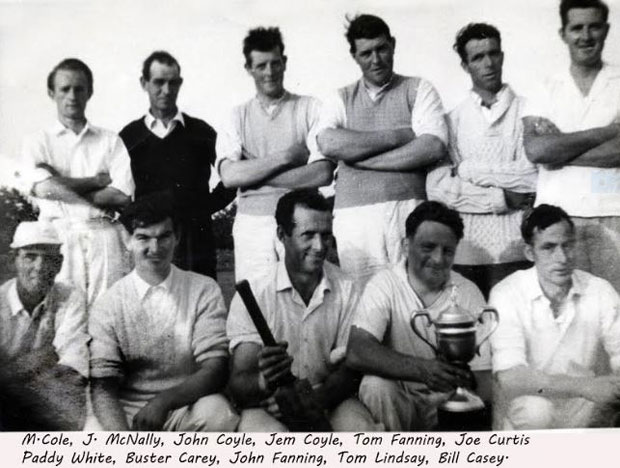
Thanks to first-hand reports from two members of the Ring Commons team (Joe Curtis and John Coyle), a newspaper advertisement naming the two teams, and a photograph of a winners' medal, it has been possible to report that Ring Commons won the final.
The New Ground, 1977
Involvement in the final in 1966 was the prelude to Ring Commons' departure from cricket, and it did not return to cricket until 1979 when it had a new ground and immediate success followed when it won the Fingal Cricket League Cup.
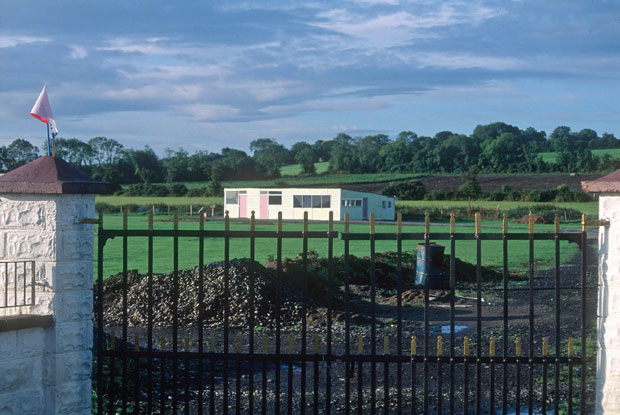
This triumph owed a lot to the White family, because Paddy White, President of the Club was the oldest playing member of the team, and he was joined by his sons, Johnny, Joe, Dermot, Peter, and Christopher. This achievement was celebrated at the Cardy Marina, Balbriggan and in addition to League medals being presented, there were also awards for Thomas Bertram (best batter and all-rounder), John Fanning (the best bowler) and Dermot White (special award).
The club which now used the title, The North Ring Commons Cricket Club also maintained its commitment to social events, and it organised a Social Evening in the Milestone, Balbriggan on 17 August 1979, with music by the McNallys and admission, £1.50. There was another Social Evening in the Milestone on 16 May 1980, and again the music was by the McNallys.
Later in the year, Ring Commons was represented at the function to mark the 50 years of the Fingal Cup, and it received medals for being runners-up in the Fingal B League.
Postscript
Ring Commons CC affiliated to the Leinster Cricket Union in 1981, and it won the Junior A League in 1982. It continued to play Leinster League cricket and Fingal League, but in 1987 it amalgamated with Knockbrack CC to form KBRC. This experiment only lasted for 3 seasons, but it was successful in the first season when its teams won the Intermediate and Junior B Leagues, and the Middle Cup.

Flooding in 2000
Ring Commons continued to play Fingal cricket until 2001, and the club was re-formed in 2011. It is a tribute to resilience and the deep-seated affection for the game, that cricket continued to be played in Ring Commons despite challenges and setbacks at different stages during the past 120 years.
A desire to re-form a cricket club in 1977 provided the impetus for the establishment of the Ring Commons Sports Centre, and the subsequent initiatives are a wonderful example of what can be achieved when clear vision is combined with concerted community action.

Johnny White batting in 2006
The structures which are now in place provide a stability which ensures that cricket will continue to thrive in Ring Commons, and it is appropriate to commend the sense of pride and community spirit which underpin a wonderful Sports Centre.
Notes
This article is dedicated to Joe Curtis, who played cricket for Ring Commons and who has done such brilliant work in preserving and photographing the social history of Fingal.

Joe Curtis
I am very grateful to Joe for being an unending source of information and for providing most of the photographs which have been used in this series of articles on the history of cricket in Fingal.
